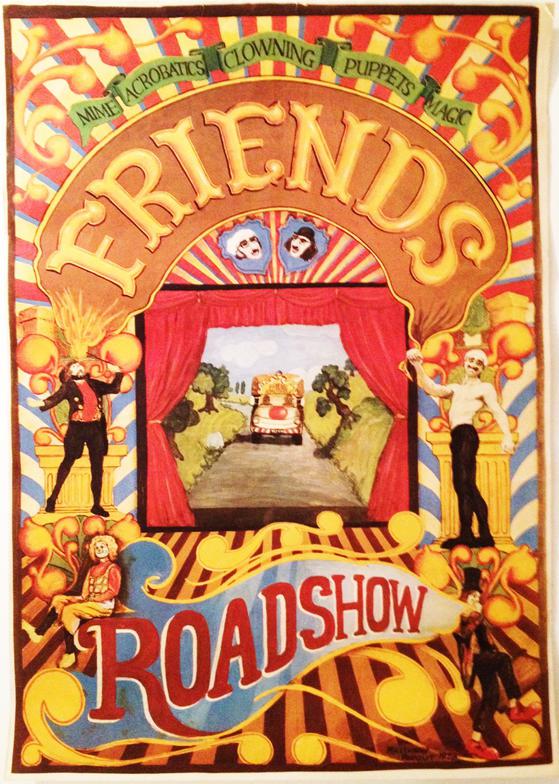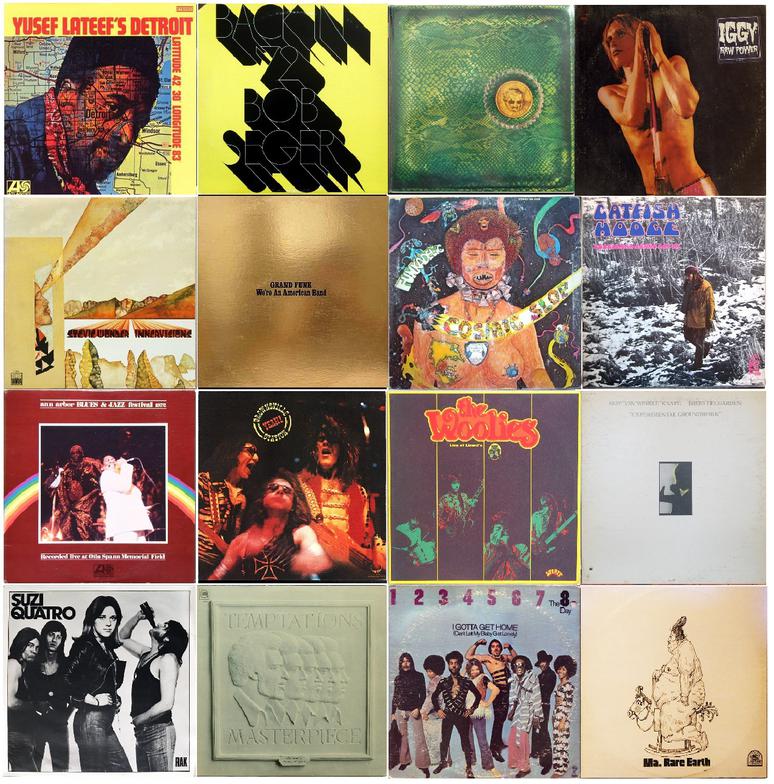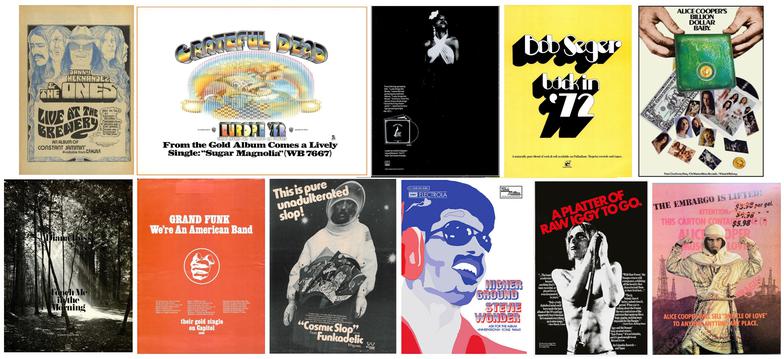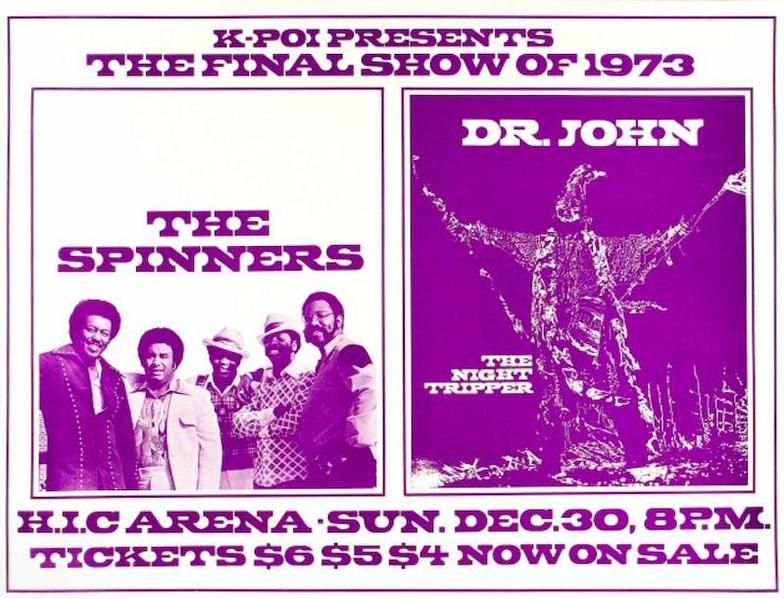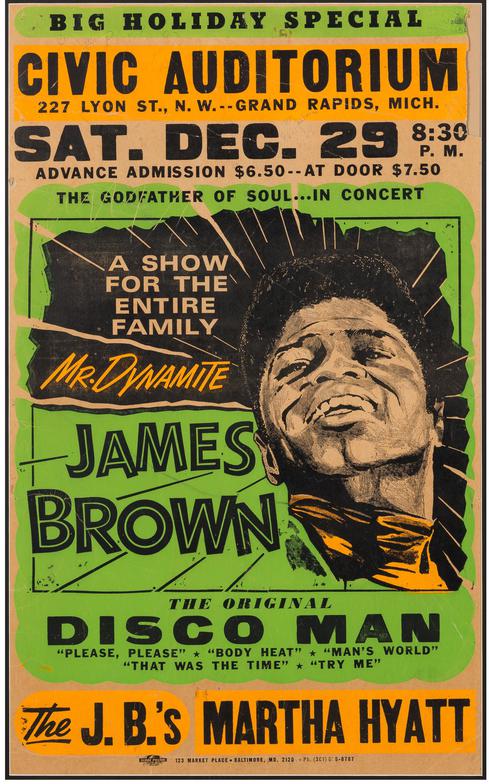Splatt Gallery
Double click here to add text.
Splatt Gallery's History of Michigan Music Posters
Volume Nine - 1973 - Page Eighteen
***********************************************************
Closer views of the Alice Cooper blacklight poster by Laurey Fisher, circa 1973.
A promo poster for the book “Rock Dreams” by Guy Peellaert and Nik Cohn, published in 1973. Originally offered as a premium to join the Columbia House Record Club, it went on to sell a million copies in its first year. Mick Jagger and David Bowie were so impressed that they each commissioned Peellaert for the cover art of their upcoming albums “It’s Only Rock ‘n’ Roll” and “Diamond Dogs”.
The book included about 120 of Peellaert’s paintings, many of the originals are owned by actor Jack Nicholson.
Detroit artists Smokey Robinson and Diana Ross as depicted by Guy Peellaert in the 1973 book “Rock Dreams”.
Illustration by Stanley Mouse & Alton Kelley for the front cover of the Grateful Dead songbook, published in 1973. The book contained sheet music and lyrics to all of the songs on the albums “Workingman’s Dead” and “American Beauty”. Each song also had an illustration panel, mostly by Mouse & Kelley as well.
The Stanley Mouse & Alton Kelley illustration panel for the song “Ripple” in the 1973 Grateful Dead songbook.
A poster for the Friends Road Show by Matthew Ridout, 1973.
Another poster for the Friends Road Show, 1973.
Our annual year-end round-up of Michigan record albums. 1973 was a decent year with a number of stand-outs, “Raw Power”, “Back in ‘72”, Yusef Lateef’s “Detroit”, “Innervisions”, “Cosmic Slop”, and the release of the recording of the 1972 Ann Arbor Blues & Jazz Festival, are albums that we still regularly listen to forty-six years later.
Chart-successful albums from Grand Funk and Brownsville Station. Albums that bore the mark of their producers, Bob Ezrin’s “Billion Dollar Babies”, Norman Whitfield’s Temptations “Masterpiece” and Rare Earth “Ma”, Holland-Dozier-Holland with 8th Day’s second album. Debut solo albums from Catfish Hodge and Suzi Quatro (brother Michael’s Jam Band released their second album, not shown), and final albums by the Woolies and Teegarden & Van Winkle.
And then there was an album, made in England, from the God of Hellfire himself, Arthur Brown, that is largely to the credit of Michigan musician Victor Peraino. Our long-time readers may recall that Peraino was the original drummer in The UP, replaced not too long after by Scott Bailey when Peraino went to England where he joined Arthur Brown’s group Kingdom Come.
Kingdom Come’s third album, “Journey” was released in 1973 with major contribution by Peraino on keyboards, in particular the Mellotron. The album is also cited as being the first to use a drum machine, mainly because the band, ironically, could not find a drummer. This would be the band’s last album as Brown departed to India for a meditative hiatus, Peraino acquired the rights to the band’s name and came back to Detroit to form Victor Peraino’s Kingdom Come.
Largely ignored upon its release, Kingdom Come’s “Journey” is now considered a classic holy grail of the genre called “space rock”.
Kingdom Come – Journey (album) (1973)
https://www.youtube.com/watch?v=77Zt1hxvduY
The 1973 original release of the Kingdom Come album “Journey”, with the 1974 reissue, the 1976 German release, the 1991 South Korea release, and the 1999 CD reissue.
The single “Calm Before The Storm/Black Magic, White Magic” by Phantom’s Divine Comedy, released on Dave Leone’s and Punch Andrews’ Hideout Records label in 1973. The forthcoming album, which will create a stir with Doors’ fans as being a lost solo album recorded prior to Jim Morrison’s death or even that Morrison was still alive, in hiding and recording music , will be released in 1974.
Phantom's Divine Comedy - Calm Before The Storm (1973)
https://www.youtube.com/watch?v=z84AeMJC6oM
Phantom's Divine Comedy - Black Magic/White Magic (1973)
https://www.youtube.com/watch?v=mf6JRUxQ2X4
A collection of picture sleeves for singles released by Alice Cooper in 1972-1973. All of them charted much higher in the UK than in the USA. “School’s Out” reached #1 in the UK while peaking at #7 in the US. Three of them, “Elected”, “Hello Hooray”, and “No More Mr. Nice Guy” all made it into the Top Ten in the UK, while in the US none of them charted any higher than #25. One exception was “Billion Dollar Babies” which although it only made it to #57 in the US, it did not chart in the UK.
An ad with Discount Records of Ann Arbor’s Top 10 Albums of 1973. It included five Beatles albums, two Pink Floyds, Traffic, Steve Miller, and The Band.
The twelve issues of CREEM magazine from 1973. Only one Michigan artist, Alice Cooper, had a cover appearance.
Shown above are all 20 of the publications from the Ann Arbor SUN newspaper in the year 1973. Nineteen seventy-three was a year of transition for the SUN. There was a three-month gap in publishing the full paper, during which a few one-sheet flyers were published. Combined with some supplement issues, there were only 13 editions of the full paper in 1973.
The explanation for the lack of production was both financial, as the funding from the Rainbow People’s Party ended, and logistical, as they vacated their premises from the basement of the 1520 Hill Street house. First, to the address next door when plans to move to the Washington Street Community Center went up in smoke, (literally the building caught fire just before Mitch Ryder’s set in December 1972), then finally a new home at 208 S. First Street, right above the Blind Pig café. It took a few more months getting settled until they resumed their bi-weekly (once every two weeks) publication.
The other significant development was the arrival of Barbara Weinberg, who joined the staff right after the move, she became a member of the Editorial Board with the July 12th issue (for which she also made the front cover art – the blue one on the right in the second row), she then moved up to Managing Editor, and was the paper’s Art Director by the end of the year.
And finally, the September 5th “Back to School” issue had a note of thanks to contributing artist Chris Frayne, who will become a staff member with the first issue in 1974. The September 5 issue (Luther Allison cover) also announced that the Rainbow Peoples Party had relinquished the publication of the SUN.
A collage of photos and drawings by Barbara Weinberg from issues of the Ann Arbor SUN newspaper from 1973.
A selection of ten Michigan Rock Posters for 1973:
Tommy – Pease Auditorium, Ypsilanti – artists Mike Brady and Gary Grimshaw
Earl Scruggs – The Brewery, Lansing – artist Terry O’Connor
Iggy & Seger – St. Clair Shores – artist Gary Grimshaw
1973 Ann Arbor Blues & Jazz Festival – artist Gary Grimshaw
Humun Ivy – Goodman Ballroom, East Lansing – artist unknown
Halloween Howl – Michigan Palace, Detroit – artist unknown
The Dogs – Silver Lake, Shelby – artist Dennis Preston
Primo Showbar – Ann Arbor – artist Gary Grimshaw
Iggy & the Stooges – Michigan Palace – artist unknown
New York Dolls – Michigan Palace, Detroit – artist Dennis Loren
Waterford, Michigan is a Township about 40 miles northwest of Detroit, with a population of about 70,000 people (93% white) and at least 34 lakes. It was home to Detroit Tigers star Kirk Gibson, CREEM magazine writer Dave Marsh, and a band that formed in 1973 called The Punks.
In similar fashion to “lost legends” such as Sugarman Sixto Rodriquez and A Band Called Death, The Punks languished in obscurity until being “discovered” decades later. We will be posting many more of their records as we continue, but for starters, here is the trailer from a documentary project, never completed (?), by Chains of Madness Pictures in 2016.
My Time’s Coming: The Story of The Punks (2016)
https://vimeo.com/170396583
Released in 1973, “Detroit 9000” was shot on location throughout the city, including the Sheraton Cadillac Hotel, J.L. Hudson’s, the Fort Street Terminal train station, Detroit Police headquarters, Sacred Heart Seminary, Detroit Memorial Hospital, and the Elmwood Cemetery. Local radio personalities Dick Purtan and Martha Jean The Queen Steinberg have small roles, as well as the Detroit Police Chief at the time, John Nichols. Also features some Holland-Dozier-Holland songs. “9000” was Detroit Police radio code for “officer down”. Quentin Tarantino was a fan and he re-released the movie in 1998.
Detroit 9000 (Movie Trailer) (1973)
https://www.youtube.com/watch?v=drWnXchUaYo
Detroit 9000 (Full Movie) (1973)
https://www.dailymotion.com/video/x2rvfqv
By a rough count, we have documented around 300 Michigan concert posters for the year 1973, nearly an exact match to 1972.
About (60) of the 1973 posters were by “an unknown artist”, some of which are shown above.
Gary Grimshaw topped (100) posters for the year, once again, on the top spot for the poster artists and possibly his career peak year.
Dennis Preston was second with nearly (50) posters, down just slightly from his peak year in 1972. Two other Lansing artists, Doug Huston and Terry O’Connor were next, each with around (20) posters for the year.
New artists that premiered in 1973 were the mysterious “G”, Amy Horowitz, Crow Quill, and Destroy All Monsters.
Volume Nine - 1973 - The End
Return to main History page - HERE
A selection of ten record company ads from 1973:
Danny Hernandez & the Ones
Grateful Dead (Stanley Mouse)
Diana Ross – Lady Sings the Blues
Bob Seger – Back In ‘72
Alice Cooper – Billion Dollar Babies
Diana Ross – Touch Me in the Morning
Grand Funk – We’re an American Band
Funkadelic – Cosmic Slop
Stevie Wonder – Higher Ground
Iggy & the Stooges – Raw Power
Alice Cooper – Muscle of Love
A selection of fifteen out-of-state posters with Michigan performers from 1973:
Bob Seger and Mike Quatro – Aragon, Chicago – March 23
Stevie Wonder – Tower Thater, Philadelphia – March 23
The Dogs – Circus, NYC – October 26
MC-5 (Wayne Kramer) – Hanna’s, - October 16-17
Brownsville Station – Saylor’s Lake, - August 5
Rare Earth – University of Utah – November 16
Suzi Quatro – Plymouth, England – July 17
Commander Cody & His Lost Planet Airmen – Armadillo, Austin, Texas – Nov 28 – Dec 1
Rare Earth – British Rock Meeting, - September 22-23
Brownsville Station – Duluth, Minnesota – July 29
Stevie Wonder – Evansville, Indiana – July 1
Brownsville Station – Camdenton, Missouri – July 4
Ted Nugent & Amboy Dukes – Aragon, Chicago -
Commander Cody & His Lost Planet Airmen – Armadillo, Austin, Texas – April 27-28
Al Green – Dallas, Texas – July 1
The second and third issues of Tribe magazine, issued in the latter half of 1973.
A Buddah Records ad at the end of 1973, promoting an impressive list of accomplishments for Gladys Knight & the Pips in their first post-Motown year. Right after the group departed Motown in February 1973, after six and a half years with the label, their final Motown single, the ironically, or purposely, titled “Neither One of Us (Wants to Be the First to Say Goodbye)” took off on the charts, staying at #1 on the Billboard Soul Singles chart for four weeks, and reaching #2 on the Hot 100, their most successful Motown single since 1967’s “Heard It Through the Grapevine”.
In August 1973, their second release on Buddah Records, “Midnight Train to Georgia” did even better, hitting #1 on both the Soul Singles and the Hot 100 charts. It earned the group their first Grammy at the 1974 Awards Ceremony, a short time later on the same night, they won their second Grammy, for “Neither One of Us”.
The “golden era” of blacklight posters arguably occurred from the late Sixties through the mid-1970’s, although the Day-Glo Color Corporation was founded in Cleveland, Ohio in 1946. The Alice Cooper poster by artist Laurey Fisher shown above is dated 1973. When they fell out of favor, they fell hard and were derisively viewed as a relic, that is until a resurgence in the mid-2000’s. As of 2014, there were at least five companies actively producing new and classic flocked (black velvet) blacklight posters in a wide range of content.
Poster by an unknown artist for New Year’s Eve, December 31, 1973, at the Mad Hatter in Louisville, Kentucky, with two Michigan groups, both mis-spelled, Ted Nugent & the Amboy Dukes and the Bob Seger System.
A 1973 year-end Motown Records ad touting Stevie Wonder’s accomplishments for the year, including #1 Male Vocalist of the Year in Billboard, Cash Box, and Record World magazine polls, and #1 Pop Artist of the Year in Downbeat magazine. And a Stevie Wonder "personality poster" by RCA Victor, circ a1973
The Great Lakes Mink Association (GLMA) was formed in 1941 by mink breeders in the Great Lakes region of the United States who bred a black-furred mink which they characterize as "the richest, deepest, most lustrous dark mink with the lightest, most flexible leather", and trademarked it as Blackglama. Their long-running advertising campaign is known by the tagline "What becomes a Legend most?", featuring a series of celebrities modeling their furs.
The series began in 1968 with Lauren Bacall, Melina Mercouri, Bette Davis, Barbra Streisand and Judy Garland. Diana Ross joined the elite club in 1973.
As the New York Dolls were in Detroit for New Year’s Eve, Iggy Pop was in New York City for the celebratory night, appearing at the Academy of Music with our friends Teenage Lust and Blue Oyster Cult, December 31, 1973.
An article by Dave Marsh in the December 1973 issue of CREEM magazine, provided a summary overview of the bands in the New York “glitter punk” scene. Marsh considered the New York Dolls and Blue Oyster Cult as the two bands with the most potential on a national level, and listed eight bands that he thought would probably never make it beyond NYC, including a group that “looks as if it just stepped out of the underground movie Pink Flamingos”, called KISS.
Alice Cooper wrapped up the year with a New Year’s Eve show in Buffalo, New York, December 31, 1973 with a vivid color-variation of the tour poster.
Returning to the Michigan Palace in Detroit, the same venue as their Michigan debut just three months earlier, the New York Dolls performed a New Year’s Eve show on December 31, 1973, with this poster by an unknown artist.
WABX-FM radio in Detroit broadcast the show which was released as a bootleg and later an official release in a three-CD box set. Here is CD-1 with the Detroit show following three tracks from Paris 1973, and followed by another set from Long Island 1974.
New York Dolls – From Here to Eternity, CD-1 (live in Detroit 12/31/73)
https://www.youtube.com/watch?v=m5H_Jw-Mo38
Newspaper ad for the New York Dolls at the Michigan Palace in Detroit, Michigan, New Year’s Eve, December 31, 1973.
Poster for the Spinners with Dr. John in Honolulu, Hawaii on December 30, 1973.
A newspaper ad with Del Shannon appearing in Willoughby, Ohio on December 30, 1973.
Gary Grimshaw poster for Sun Ra at the King Pleasure jazz club in Ann Arbor, Michigan, New Year’s Eve, December 31, 1973, and New Year’s Day, January 1, 1974.
A classic Globe Poster for James Brown with The J.B.’s and Martha Hyatt, at the Civic Auditorium in Grand Rapids, Michigan, December 29, 1973. It re-uses the “Mr. Dynamite” illustration from the 1962 poster for a show at the Apollo Theatre, that was used over and over again, but it’s a good one, and those green and orange inks are super tasty.
Another thing that is interesting about this poster is the use of the phrase “The Original Disco Man”, which would become the title of a James Brown album six years later in 1979. The listing of the song “Body Heat” was not released until three years later in 1976. Finally, not to quibble, but the song title “That Was the Time” should have been “There Was A Time”.
So what to make of this? Unfortunately, as far as we know, there is no complete database of Globe Posters, for a company that was cranking out twenty-plus posters per day for eighty years, it must be an insurmountable task, but if anyone knows of a list, let us know.
The mistake on the title of “There Was a Time” is a minor one, not uncommon, and could be excused. More troubling is the song “Body Heat”, even if the song was being performed live, three years before putting it on wax, it would not be well-known enough to warrant a place on a poster.
Finally, as our readers have just recently seen, we were able to pinpoint the birth of “Disco” to David Mancusco’s NYC apartment building in 1970, and the term was just starting to catch on. By the time we get to 1979, disco will have surpassed funk in popularity, and in a deliberate effort to emphasize his still-remaining relevancy, Brown titled his album “The Original” to remind everyone, but we have to find it very unlikely that he was going by the title in 1973.
Otherwise, it’s a gorgeous poster, the nice resolution on this photo shows a clean Globe Poster imprint, with a little under-stamping to leave some faintness, and some creases, scratches and scribbling to give it a vintage, worn provenance, even a missing corner, but we’re tending to believe that this is a fake or a counterfeit, a beauty nevertheless.
A newspaper ad that was likely taken from a poster, notice the detail of the small heads in the elaborate border, for the Second Annual Holiday Festival at the Indianapolis Convention Center on December 29, 1973, headlined by Rare Earth and also featuring Iggy & the Stooges.
Record company ad from December 1973, summarizing Suzi Quatro’s year of success with the single “Can the Can”, two million sold, if we’re reading that right, and #1 in Spain, Switzerland, Australia, England, France, West Germany, “…and breaking in Japan”, (and conspicuously missing in the USA).
Record company marketing was still blatantly sexist, we’ve found countless examples, and here, when Bell Records touts “The Whole World Knows Her Vital Statistics”, passing it of as #1, #1, #1…, there’s no doubt they knew full-well the double-entendre of the informal British definition of “vital statistics” as “the measurements of a woman’s bust, waist and hips”.
Dennis Preston poster for Magic with Mission and St. Elmo’s Fire at the Washington Street Armory in Lansing, Michigan, December 29, 1973.
Born Donaldson Toussaint L’Ouverture Byrd II in Detroit, Michigan, a graduate of Cass Tech High School, already performing with Lionel Hampton before graduation, Donald Byrd obtained a bachelor’s degree from Wayne State University and moved to New York City. While attending the Manhattan School of Music he joined Art Blakey’s Jazz Messengers, leaving the band in 1956 to perform and record with artists such as John Coltrane, Sonny Rollins, and Thelonious Monk, all while continuing to teach music education at various universities.
Byrd became a mentor to a young Herbie Hancock, giving him room and board, and including the first recordings of Hancock compositions on two of Byrd’s albums in 1961 and 1962. Hancock also credits Byrd for encouraging him to record his debut album on Blue Note Records, introducing him to Mongo Santamaria, who turned “Watermelon Man” into a hit record, and also for encouraging him to accept a position in Miles Davis’ band.
Hancock also credits Byrd with the most important advice he’d been given; to always maintain the publishing rights to his compositions, advice that really paid off when “Watermelon Man” hit big. Hancock used his first royalty check to buy a 1963 Ford Mustang Shelby Cobra (recommended by Donald Bryd) which he apparently still owns, making it the oldest production Cobra still owned by the original owner.
In 1973, Byrd reconnected with another of his former students at Howard University, Alphonso “Fonce” Mizell. Mizell had become a member of “The Corporation” at Motown Records, the team of writers and producers brought in to replace Holland-Dozier-Holland after they had left to form Invictus Records. The Corporation produced the string of number-one hit singles for the Jackson Five, they were disbanded in 1972 when Motown moved to Los Angeles and Hal Davis assumed production duties for the Jackson Five. Fonce Mizell and his brother Larry formed a partnership with Donald Byrd, releasing two albums in 1973, “Black Byrd” and “Street Lady”, the first two of a string of great albums to follow.
Donald Byrd was back in Detroit for performances at the King’s Row Lounge to finish out the year, December 28-31, 1973.
Donald Byrd – Lansana’s Priestess (1973)
https://www.youtube.com/watch?v=hzd1wcRfRD8
Newspaper ad for the “Bob Seger System” in Willoughby, Ohio on December 27, 1973. Although the System had been long dis-banded, promoters had not gotten the memo.
Dennis Preston poster for Charles Mingus at The Stables in East Lansing, Michigan, December 27-31, 1973.
Poster for Ted Nugent & the Amboy Dukes in Montgomery, Alabama on December 28, 1973.
The splashes read, "For those who dare attend Ted Nugent's live performance, keep repeating to yourself: "He's only human"." - and - "Ted Nugent, world's fastest guitarist, will actually disintegrate glass with a single note".
An ad with the Rockets opening for the Charlie Daniels Band at the Coliseum near Cleveland, Ohio on December 28, 1973.
Season’s greetings, Christmas 1973, by Dennis Preston for the Sounds & Diversions store in Lansing, Michigan.
Poster/flyer for Iggy & the Stooges at the Latin Casino in Cherry Hill, New Jersey on December 26, 1973.
Poster/ad for Alice Cooper with ZZ Top in Montreal, Canada on December 27, 1973.
Aretha Franklin on the cover of the December 21, 1973 issue of the British music magazine Blues & Soul.
Poster/handbill for Alice Cooper’s “Billion Dollar Babies” show, with ZZ Top, in Tampa, Florida on December 22, 1973. It uses the standard tour poster art that we’ve seen so often, but this is a particularly nice image.
Poster/flyer by Gary Grimshaw for a Christmas Party at the Primo Showbar in Ann Arbor, Michigan with the Lyman Woodard Trio, featuring Ron English, and the Muggles Bros. on December 23, 1973.








